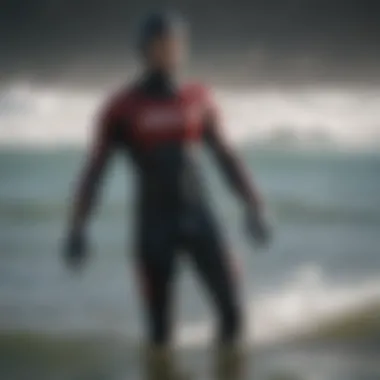Understanding Kiteboarding Wetsuits: A Comprehensive Guide


Intro
Kiteboarding, a sport that melds the thrill of sailing with the adrenaline of surfing, has captivated adventurers worldwide. As this exhilarating sport evolves, so does the equipment designed to enhance performance and comfort. Among the most crucial pieces of gear is the wetsuit, a fundamental component in kiteboarders’ ensembles. In this guide, we will explore the intricacies of kiteboarding wetsuits, aiming to arm both newcomers and seasoned veterans with the knowledge necessary to make informed choices.
Understanding the different styles, materials, and technologies offers kiteboarders the ability to maximize their potential in the water.
In the sections that follow, we'll journey through the history of kiteboarding, dissect essential techniques, underscore safety measures, and recommend top gear options vital for maintaining peak performance while enjoying the waves.
Prolusion to Kiteboarding Wetsuits
Kiteboarding can be an exhilarating experience, but it also comes with its unique challenges, especially when it comes to water temperature and environmental conditions. This is where wetsuits become essential for riders who want to enjoy their time on the water without succumbing to the chill. Understanding kiteboarding wetsuits is not just about choosing the first one you see; it’s about knowing what works for your specific needs.
The Importance of Wetsuits
Wetsuits serve a dual purpose for kiteboarders. First, they offer thermal insulation, keeping the body warm when submerged in cooler waters. The right wetsuit can help avoid hypothermia, allowing you to focus on riding rather than shivering from the cold.
Second, a wetsuit protects against harsh elements like UV rays, wind, and even potential abrasions from your board or sea life. By limiting water exposure and providing a barrier, wetsuits can enhance your overall enjoyment and performance in the sport.
Here's what to consider about their importance:
- Temperature Regulation: A well-fitted wetsuit traps a thin layer of water that warms up with your body heat, ensuring you stay comfortable for longer durations.
- Injury Prevention: When kiteboarding, there's a risk of falls leading to cuts or scrapes. Wetsuits add an extra layer of protection against impacts and scratches.
- Confidence Boost: Knowing you are warm and protected can instill confidence in the water, allowing you to push your limits and improve your skills.
"A good wetsuit makes all the difference between a thrilling day on the water and an uncomfortable one."
Basic Components of Wetsuits
Understanding the fundamental components of wetsuits is key to making an informed choice. Most wetsuits are constructed from neoprene or similar materials designed for flexibility and warmth. Here are some critical components to consider:
- Neoprene Layers: The thickness of the neoprene affects warmth and flexibility. Wetsuits come in various thicknesses, typically ranging from 2mm to 6mm, with thicker suits being warmer but possibly compromising mobility.
- Seams: The type of seam construction plays a role in water entry. Flatlock seams are often flexible but may allow some water in. Glued seams and taped seams provide better water resistance and are generally used in higher-quality suits.
- Zippers and Entries: There are different types of closures like back zippers, chest zippers, or even no zippers at all. The closure type can dictate ease of entry and exit, as well as sealing capabilities against water infiltration.
Selecting the right wetsuit involves understanding these basics and how they align with your kiteboarding style and the conditions you plan to ride in. So dive deep into the components, letting the material speak to what you need out of your wet apparel.
Types of Wetsuits for Kiteboarding
When it comes to kiteboarding, choosing the right wetsuit can be as crucial as selecting the right board or kite. Wetsuits serve not just to protect against the chill of the water, but also to enhance performance by providing flexibility and buoyancy. Understanding the different types of wetsuits available is essential, as each type caters to varying conditions and personal preferences.
Here, we'll explore the specific features, benefits, and considerations that come with three primary types of wetsuits: full suits, shorties and spring suits, and hybrid suits.
Full Suits
Full suits are often the go-to choice for kiteboarders looking for maximum warmth and coverage.
- Advantages:
- Considerations:
- They provide full-body insulation, keeping you warm even in colder waters.
- The snug fit allows for better aerodynamics, which can enhance performance while riding.
- Although versatile, full suits can restrict mobility slightly compared to shorter cuts; however, most modern designs prioritize flexibility.
- For those hot, sunny days, a full suit can be overkill, potentially causing overheating during long sessions in the sun.
Shorties and Spring Suits
Shorties and spring suits offer a more relaxed alternative, typically covering the torso and extending to the mid-thigh or knee.
- Advantages:
- Considerations:
- These wetsuits strike a good balance between warmth and flexibility, allowing for ease of movement.
- Perfect for warmer conditions, they help to shield against the sun while providing just enough insulation for cool breezes.


- If you're kiteboarding in colder waters, shorties might not provide adequate insulation, potentially leading to a cold fatigue.
- Their design may leave you somewhat exposed to harsh elements such as wind, especially on chilly days.
Hybrid Suits
Hybrid suits are a clever blend of features from both full suits and shorties, offering versatility for various riding conditions.
- Advantages:
- Considerations:
- They usually come with full-length sleeves and shorter legs, allowing for both mobility and reasonable warmth.
- Ideal for kiteboarders who shift between climates or think ahead for seasonal transitions.
- Choosing a hybrid can be nuanced; they don't always offer the same thermal protection as a full suit nor the lightweight feel of a shorty.
- An understanding of your regular riding conditions is crucial to deciding if a hybrid is indeed the best fit.
"Selecting the right wetsuit is not merely about warmth; it reflects your style, the conditions you ride in, and your individual preferences as an athlete."
Key Features of Kiteboarding Wetsuits
When it comes to kiteboarding, the right wetsuit can make a world of difference. It’s not just about looking good on the water; it’s about performance, warmth, and protection. Understanding the key features of kiteboarding wetsuits is essential for both novices and seasoned pros who want to enhance their experience. In this section, we will break down the materials, thickness, insulation, and seam types that make up a great wetsuit.
Material Composition
Material is paramount in selecting a wetsuit. The best materials not only keep you warm but also offer flexibility and durability, which are crucial when you're out battling waves and wind.
Neoprene
Neoprene is the reigning champion among wetsuit materials. This synthetic rubber comes in different grades, affecting its insulating properties and stretching capabilities. A significant characteristic of neoprene is its ability to trap a thin layer of water between the suit and the body, keeping you warm as the water warms up from your body heat.
One unique feature of neoprene is its varying thickness, allowing for the choice of a suit ranging from summer lightweight options to thicker winter suits that can stand against the harshest conditions. However, it can also be more susceptible to wear and tear if not properly taken care. Overall, neoprene remains a go-to for kiteboarders seeking comfort and warmth.
Other Materials
While neoprene takes the spotlight, other materials are also emerging in the kiteboarding wetsuit scene. These can include natural rubber, which provides a more environmentally friendly option, and polyurethane, known for its lightweight and flexibility. Another consideration is the lining, which can be a combination of nylon or polyester, providing additional comfort. A key aspect of these alternative materials is their breathability, which can keep you dry during intense sessions. However, they may not always have the same warmth retention as neoprene, making them less ideal for colder waters. Still, for those hot summer days out on the water, they can be excellent choices.
Thickness and Insulation
The thickness of a wetsuit can heavily influence your comfort in various water temperatures. Generally, thicker suits provide more insulation, while thinner suits are designed for warmer climates. A common thickness is 3/2 mm, providing a balance between warmth and flexibility.
As for insulation, wetsuits may have additional thermal linings such as plush or fleece-backed materials that enhance warmth without adding bulk. This helps maintain freedom of movement while ensuring that you stay cozy even in cooler conditions. Keeping an eye on both thickness and insulation is smart for any kiteboarder aiming for optimal performance on the water.
Seam Types
The seams of a wetsuit can often be overlooked but hold significant importance in durability and waterproofing.
Flatlock Seams
Flatlock seams are typically the most common type. They stretch easily and lay flat against the body, which offers comfort and a reduced chance of chafing. However, since they are not sealed, they may allow water ingress, making them a better choice for warmer conditions where getting wet isn't a major issue.
Glued Seams
Glued seams, as the name suggests, use adhesive to bond the pieces of fabric together. This method gives a significant advantage in terms of water resistance. While they might not stretch as freely as flatlock seams, they do provide a snug fit that helps keep the chill at bay.
Taped Seams
For those considering maximum protection against water, taped seams offer the best of both worlds. Taped seams feature adhesive strips on the inside, complementing glued seams to create an almost impenetrable barrier against water. This means you can enjoy your kiteboarding session longer without feeling the bite of cold water. It is a solid option for those venturing into very cold conditions.
"Choosing the right wetsuit is the first step to enjoying your kiteboarding experience to the max. Consider the features carefully, and you'll reap the benefits on the water."


In summary, the key features of kiteboarding wetsuits include material composition, thickness for insulation, and the various seam types available. Each element serves a purpose and maintains a delicate balance between comfort, performance, and protection. Understanding these features will help any kiteboarder select the perfect wetsuit for their adventurous outings.
Selecting the Right Wetsuit for Kiteboarding
Choosing the ideal wetsuit for kiteboarding is not just about looking good on the water; it’s about ensuring comfort, performance, and safety. The right wetsuit acts as a second skin, allowing for maximum mobility while providing essential thermal protection against chilly winds and waters. Poor fit or inappropriate style can lead to discomfort, decreased performance, and even safety hazards. Thus, understanding the nuances of wetsuit selection is crucial for anyone keen on kiteboarding.
Understanding Fit and Size
Fit is perhaps the most critical aspect when it comes to wetsuit selection. A wetsuit that’s too loose will allow water to flow inside, robbing you of warmth and buoyancy. Conversely, a suit that’s too tight can restrict movement and cause pressure points that might distract from your focus on riding the waves.
- Measuring Properly: To find the right size, it’s necessary to take your measurements accurately. Focus on your height, weight, chest, waist, and inseam. Each brand has its sizing chart, and a quick reference can help you avoid mishaps.
- Try Before You Buy: If possible, try on the wetsuit before purchasing. It should feel snug but not restricting. When you move your arms and legs, the fabric should stretch without pulling on your skin or digging into you.
- Body Shape Considerations: Body shapes differ, and some brands cater to specific silhouettes better than others. Understanding your body type helps you choose a style that fits well and complements your natural shape.
"Selecting a wetsuit is often compared to finding a partner; it should fit well and feel comfortable when you dive into the deep end."
Consideration of Water Temperature
Water temperature significantly informs the type of wetsuit you should choose. Wetsuits are categorized by thickness for a reason: different conditions require tailored responses.
- Thinner Suits (2-3 mm): Ideal for warmer waters, allowing for flexibility while still providing some insulation.
- Mid-Range Thickness (3-5 mm): A versatile choice for transitional seasons or locations where the water isn’t too cold.
- Thicker Suits (5 mm and up): Essential for frigid waters to retain body heat, allowing you to stay in the water longer without succumbing to the cold.
Before heading out, check the water temperature and weather conditions to select a wetsuit that aligns with your ride plans.
Personal Preferences and Styles
Finally, personal preference plays a significant role in the selection process. Kiteboarding is not just a sport; it’s a lifestyle, and your wetsuit can reflect your style and personality.
- Color and Design: From bright hues and patterns, to sleek darker tones, choose a wetsuit that resonates with you. After all, we all want to look good while catching air!
- Cut Styles: Think about what cut you prefer. Full suits provide maximum coverage, while shorties can be more convenient for warmer days. Each style offers distinct advantages; weigh them based on your intended use.
- Functional Elements: Consider features like pockets for small items, reinforced knees for durability, or easy entry designs. As kiteboarding adventures can be spontaneous, having a suit that meets your functional needs is paramount.
In the end, the process of selecting a wetsuit requires thoughtful consideration of fit, function, and personal style. Investing time in choosing the right wetsuit will undoubtedly enhance your kiteboarding experience.
Wetsuit Care and Maintenance
Taking care of your wetsuit is vital for maximizing its lifespan and maintaining optimal performance in the water. Proper care ensures that your wetsuit retains flexibility, warmth, and structural integrity, which is crucial, especially for kiteboarding where conditions can vary significantly. This section will discuss essential cleaning techniques, storage guidelines, and methods for repairing minor damages to your wetsuit.
Proper Cleaning Techniques
Cleaning your wetsuit correctly is not just about keeping it looking sharp; it also preserves its functionality. After each kiteboarding session, rinse your wetsuit with fresh water to remove salt, sand, and chlorine, which can degrade materials over time. Make sure you use cold water, as hot water can damage the neoprene and lead to losing its shape.
Here's how to do it right:
- Rinse inside and out. Start by turning it inside-out and rinsing the inner lining, then give the outer layer a thorough rinse.
- Use a wetsuit cleaner. Occasionally, use a mild wetsuit-specific soap to help eliminate stubborn odors or salt build-up. Avoid harsh detergents because they can strip away the protective coating.
- Dry properly. Hang your wetsuit on a wide hanger away from direct sunlight or heat sources. This way, the material stays in good condition.
"Taking care of your wetsuit is like looking after your best friend; it’s got your back on those wild rides!"
Storage Guidelines
Storing your wetsuit properly can be the difference between a suit that lasts for several seasons and one that becomes unusable after just a few months. Here are some key practices:
- Avoid folding. Always hang your wetsuit instead of folding it to prevent creases and damage to seams.
- Choose the right hanger. Use a thick, padded hanger designed for wetsuits to support their weight without causing deformities.
- Assess your storage temperature. Keep your wetsuit in a cool, dry place. Extreme temperatures can either cause the material to harden or become too soft and lose its shape.
If you have multiple wetsuits, consider using a large, breathable bag for storage.
Repairing Minor Damage


Over time, your wetsuit may suffer minor damages such as small tears or seam separation. Addressing these issues quickly can prevent them from worsening. Here are some tips on how to make simple repairs:
- Identify the damage. Inspect your wetsuit regularly for any signs of wear and tear, particularly in high-stress areas like shoulders and knees.
- Use neoprene glue. For small cuts, apply a suitable neoprene adhesive. Clean the area first and let the adhesive cure as per the instructions on the packaging.
- Sew minor tears. If the tear is larger, don’t hesitate to stitch it up with a needle and special thread designed for neoprene. Ensure you seal the edges with glue to prevent fraying.
By making these repairs promptly, you can extend the life of your wetsuit significantly.
Innovations in Wetsuit Technology
In the dynamic sport of kiteboarding, equipment can make or break your experience. As kiteboarding gains popularity, wetsuit technology has evolved significantly. These advancements not only improve performance but also enhance comfort and safety, crucial for enthusiasts braving the elements. In this section, we will explore the latest innovations that redefine how we think about wetsuit functionality, from material enhancements to eco-conscious designs and tech-savvy features.
Advanced Insulation Materials
Wetsuits have come a long way since their inception. The primary goal of insulation is to keep the body warm, particularly in colder waters. Modern wetsuits now employ advanced materials that outperform traditional neoprene. For instance, specialty foams provide superior heat retention while maintaining flexibility.
- Air-cell structures in these materials trap more warmth because they incorporate tiny bubbles giving thermal structure without adding bulk.
- Some brands have introduced materials like Yamamoto neoprene, a limestone-based alternative that's lighter and retains heat more effectively than standard neoprene.
This shift not only benefits performance but also improves movement, allowing kiteboarders to experience greater freedom while maneuvering on the water.
Eco-Friendly Options
Sustainable practices are becoming essential as environmental awareness grows among outdoor enthusiasts. In the wetsuit industry, brands are taking strides to reduce their carbon footprint. Eco-friendly wetsuits are often made from recycled materials and new plant-based polymers.
- Recycled neoprene is crafted from scrap tires and other materials, emphasizing a circular economy in product design.
- Moreover, some companies employ biodegradable materials that break down over time, reducing long-term waste in oceans and landfills.
Choosing eco-friendly wetsuits helps kiteboarders do their part in protecting the ocean, aligning their passion for the sport with a commitment to sustainability.
Smart Wetsuits
In the age of technology, innovation has led to the creation of smart wetsuits that integrate wearable technology.
- These suits can monitor everything from body temperature to heart rate, providing real-time feedback to riders.
- Certain models even feature built-in GPS tracking systems that enhance safety by allowing friends or rescue teams to locate a rider in distress.
Smart wetsuits tap into the potential of data collection for performance optimization and safety measures during kiteboarding sessions. Such technology might seem futuristic, yet it’s increasingly accessible to adventurous athletes seeking to push their limits.
Ultimately, the incorporation of these innovations is setting new standards in the kiteboarding world. As a kiteboarder, recognizing and understanding these advancements can transform your experience in the water, allowing you to not only ride better but also with peace of mind.
Wetsuit Brands and Recommendations
Choosing the right wetsuit can make or break your kiteboarding experience. Various brands offer unique features, making the selection a bit overwhelming. Oftentimes, the reputation of established brands goes a long way in ensuring quality and performance. When you dive into the world of wetsuits, it's essential to understand what specific elements to look for in a brand—such as reliability, customer support, and innovation. With kiteboarding being such an adventurous sport, your gear should match that spirit.
Furthermore, the investment in a good wetsuit can significantly enhance comfort and performance on the water. As we've learned already, wetsuits differ in fit, thickness, and materials, therefore understanding brand offerings can better help you navigate this complex landscape.
Top Brands in the Market
When it comes to wetsuits tailored for kiteboarding, several brands consistently rise to the top. Each brand has its quirks, strengths, and weaknesses. Below are some noteworthy names known for their top-notch wetsuits:
- O'Neill: Pioneering in wetsuit technology, O'Neill has been around for decades. Their wetsuits often emphasize flexibility and warmth without compromising durability. If you want to hit the water with confidence, this brand might be the way to go.
- Rip Curl: Known for their surf gear, Rip Curl also excels in the kiteboarding segment. Their wetsuits usually feature cutting-edge materials that enhance comfort, giving you an edge when you're gliding through waves.
- Billabong: This brand is synonymous with beach culture. The Billabong wetsuits often combine style with performance, making them a popular choice among young kiteboarders.
- Mystic: They focus on creating specialized gear for kiteboarding and other water sports. Mystic wetsuits are designed with the capabilities of kiteboarding in mind, offering excellent flexibility and protection.
- Patagonia: Known for their commitment to the environment, Patagonia also produces quality wetsuits using eco-friendly materials. They appeal to those who want to make responsible choices without sacrificing performance.
Selecting the right brand can influence not just fit and durability but also your overall kiteboarding experience. Choose wisely!
Budget vs. Premium Choices
The market offers wetsuits that range from affordable to high-end premium options. Understanding your budget and what you value in gear is crucial.
- Budget Wetsuits: These options generally provide basic features at a lower cost. They often lack the advanced materials and technologies present in pricier models. If you're just starting out or kiteboarding casually, a budget wetsuit could suffice, but ensure that it at least meets your basic needs. Look for:
- Premium Wetsuits: For serious enthusiasts, investing in a premium wetsuit can significantly enhance your performance. Premium models often use advanced neoprene, which offers better insulation and flexibility while reducing bulkiness. These suits also tend to be more durable and resistant to water entry. Benefits of spending a bit extra include:
- Sufficient warmth for your local waters.
- Decent flexibility to allow for movement.
- Reasonable durability to withstand wear and tear.
- Superior fit due to advanced sizing options.
- Enhanced comfort during extended use.
- Better warranty and customer support services.







